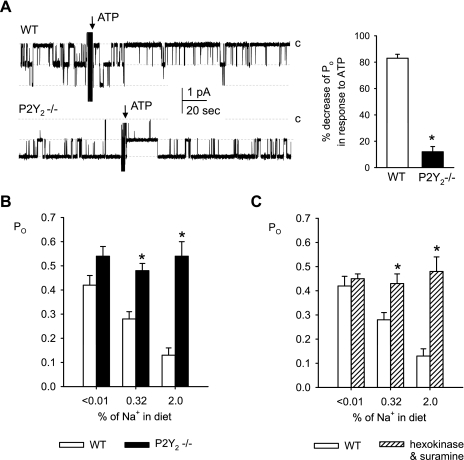Fig. 1.
P2Y2 receptor activation determines the inhibitory effect of ATP as well as of dietary salt on epithelial sodium channel (ENaC) open probability (Po). A: representative continuous current traces from cell-attached patches on principal cells (containing ≥2 ENaC's) before and after application of ATP (100 μM) in connecting tubules (CNTs)/cortical collecting ducts (CCDs) harvested from wild-type (WT) and P2Y2 receptor knockout (P2Y2−/−) mice fed a regular 0.32% Na+ diet. Patches clamped to −Vp = −60 mV, and inward Li+ currents through ENaC are downward. Dashed lines indicate the respective current levels, with c denoting the closed state. Summary graphs of ENaC Po changes in response to ATP are shown on the right. *P < 0.05 vs. WT. B: summary graphs showing that suppression of ENaC Po by dietary NaCl intake is absent in CNT/CCD of P2Y2−/− mice. Patch-clamp studies were performed after 1 wk on a given diet. *P < 0.05 vs. WT. C: summary graph showing that inhibition of local ATP signaling [hexokinase (+glucose) to degrade local ATP plus suramin to prevent P2 receptor activation] prevents regulation of ENaC Po in CNT/CCD by dietary NaCl intake in cell-attached patches from WT mice. *P < 0.05 vs. WT control. Based on and modified from Ref. 65.

